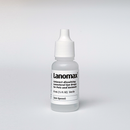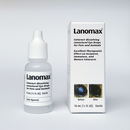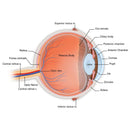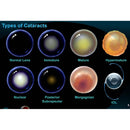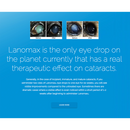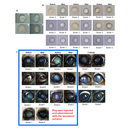Description
What is Lanomax®?
Lanomax® is a cataract-dissolving lanosterol eye drop for pets and other animals. Lanomax® uses ThruDelivery®, an innovative drug delivery system built using the latest advanced nanotechnology, to deliver lanosterol molecules into the crystalline lens of the eye. This system separates the lanosterol molecules from the carriers in the carrier-lanosterol complex attached to the corneal surface, and then quickly passes them through the cornea, anterior, iris and pupil to deliver them into the crystalline lens. It is because of this ThruDelivery® system that Lanomax® is the only eye drop on the planet to show a real therapeutic effect on cataracts.
What are the therapeutic effects of Lanomax®?
Lanomax® has an excellent therapeutic effect on incipient, immature, and mature cataracts. However, the therapeutic effect of Lanomax® varies greatly depending on the type of cataract and the degree of its progression. Generally, in the case of incipient, immature, and mature cataracts, if you administer Lanomax® to both eyes for six weeks (about two bottles), you will see visible improvements compared to untreated eyes before administering Lanomax®. Sometimes there are dramatic cases where a visible effect can even be noticed within a short period of 1-2 weeks after beginning to administer Lanomax®.
What types of cataracts can be treated with Lanomax®?
In general, cataracts fall into four categories: age-related, congenital, secondary, and traumatic. In addition, cataracts are further categorized as cortical, nuclear, or posterior subcapsular, depending on the location of their outbreak. The causes and types of cataracts vary widely, but the biochemical mechanisms underlying cataracts are similar. At the molecular level, protein aggregation is a common cause of all cataracts. Lanomax® effectively removes that protein aggregation. So, while Lanomax® is effective for all types of cataracts, it takes the most time to treat posterior subcapsular cataracts where protein aggregation occurs at the furthest position from the cornea. This is because in posterior subcapsular cataracts lanosterol molecules must confront the most barriers to reach the protein aggregation.
Can brown cataracts be treated?
Nuclear cataracts change the nucleus in the center of the lens to yellow or brown. Lanomax® has been shown to have a therapeutic effect on nuclear cataracts.
Can Lanomax® be used for animals such as birds, minks or horses?
Lanomax® can be used for cataracts that occur in all kinds of animals.
Can I use Lanomax® for animals with diabetes?
Lanomax® is safe for use on animals with age-related diseases, including diabetes.
Can Lanomax® be used on animals with glaucoma? Does it increase the intraocular pressure?
Lanomax® is safe for use on animals with glaucoma; it will not affect the intraocular pressure. However, it is unlikely to provide dramatic treatment effects in a short time if the cataract is in a hyper-mature state.
Are there any side effects when using Lanomax®?
No, Lanomax® eye drops are safe for both pets and other animals. Lanosterol, the active ingredient of Lanomax®, is a natural compound that is naturally occurring in the body tissue and blood of all animals. It is already present in the crystalline eye lens as this compound is what helps the lens to maintain its transparency. Therefore, it does not cause any side effects for either pets or other animals. Lanosterol, the active ingredient in Lanomax® is naturally-sourced through extraction from sheep’s wool with 99.9% purity. In the tens of thousands of animals that have been treated with Lanomax® to date, there has been only one report of any side effect at all. However, upon investigation, it was found that the side effects were caused by a lack of eye drop maintenance by the user. The tip of the bottle was exposed to an infection that was then passed on to the eye. Providing you follow the safe handling procedures to prevent contamination of the solution in the bottle, there is no need to worry about any ill effects.
How many times a day should I use Lanomax®?
To treat both eyes of a 20-kg dog, the standard minimum dosage is one to two drops in each eye three times a day. However, it is acceptable, and possibly beneficial, to exceed that dosage amount. If you need to treat a larger dog, or an eye with more severe cataracts, or if you want to see faster effects, you may need to use more drops more frequently than the standard dosage. As Lanomax® does not contain any preservatives it is perfectly safe to increase the dose; there is no dose limit.
How long will one bottle of Lanomax® last?
If you treat both eyes of your dog using the standard dosage of one to two drops in each eye three times a day, one bottle of Lanomax® will last for about 3 weeks.
Does Lanomax® include preservatives?
Lanomax® does not contain any preservatives. This means that, if necessary, it is perfectly safe to increase its use beyond the recommended dose (one to two drops in each eye three times a day). However, if the solution becomes contaminated with bacteria, it must be discarded immediately as it contains no preservatives. When administering Lanomax® to the animal's eyes, do not touch the tip of bottle to the eye or any surface to avoid contamination. Once the Lanomax® bottle has been opened, you need to keep it refrigerated to prevent bacterial growth.
Does Lanomax® contain PBS or Phosphate?
Until February 2017, Lanomax® was produced using Phosphate and PBS (phosphate-buffered saline) as inactive ingredients. However, Lanomax® produced on or after March 1, 2017 contains neither of these ingredients. We currently only produce and sell one kind of Lanomax®, which does not contain either of those ingredients. Phosphate and PBS were inactive ingredients of Lanomax®, so removing them from the formula in no way affected Lanomax®’s cataract-removing effects.
Can Lanomax® be used along with other eye drops?
Lanomax® can disturb the absorption of other eye drops because of its high viscosity that allows it to coat the surface of the cornea for a certain period of time after applying. Other drops may have other effects that could impede the therapeutic effects of Lanomax®. Therefore, avoid using Lanomax® at the same time as other eye drops unless it is unavoidable. If you must use other eye drops along with Lanomax®, please apply the drops at least 3 hours apart, administering each eye drop separately.
Is the application of Lanomax® painful to animals?
No, there is no pain at all when using Lanomax®. It is similar to using artificial tears.
Do I need a prescription and veterinarian involved to use Lanomax®?
No, Lanomax® does not require consulting a veterinarian or getting a prescription.
What is the shelf-life of Lanomax®?
Lanomax® bottles remain usable for up to 30 days after being opened. As Lanomax® contains no preservatives, it is important to follow safe handling procedures. Do not allow the tip of the dropper to touch your animal’s lashes or skin, and make sure the bottle is kept refrigerated. Unopened Lanomax® bottles may be stored at room temperature for 24 months from the date of manufacture.
Is it a problem if Lanomax® is exposed to high temperatures during its delivery?
Unopened Lanomax® bottles may be stored at room temperature for 24 months from the date of manufacture. In addition, the Lanomax® eye drop solution is very stable and thus is not affected by temporary exposure to high temperatures. However, the container holding the drops has a lower heat resistance, so avoid exposing it to very high temperatures over 90°C.
It is very sticky when you touch the substance with your hands. Why?
The reason for the high viscosity of Lanomax® eye drops is due to the compound hydroxypropyl-ß-cyclodextrin (HPßCD), which is used to maintain long-term adherence without flowing away from the corneal surface. This compound has a large molecular weight and cannot pass through the cornea, so it remains on the surface of the eye and is eventually naturally flushed out by the eye, sometimes creating tangles in the animal's fur. When cleaning the fur around the animal's eye, please do not use combs. Instead, wash gently with water.
During the use of Lanomax®, the cataracts split into multiple fragments. What causes this?
It is a desirable phenomenon to see the protein aggregation (the cause of cataract) is dissolving. This is nothing to be alarmed about and you should continue the treatment.
I am using the second bottle of Lanomax®, but the second bottle seems to be less effective than the first. Why?
This can happen when cataracts occur in two or more locations. For example, when cortical cataracts and posterior subcapsular cataracts occur simultaneously, the therapeutic effect of Lanomax® will first appear in the cortical cortex which is near to the cornea. However, because the posterior subcapsular cataract is relatively farther away from the cornea than the cortex, a smaller amount of lanosterol molecules are reaching the location and it takes a longer period of time for the molecules to reach the area. Therefore, the treatment effect can be much slower, and give the appearance that the second bottle is less effective.
Will it cause any problems if the Lanomax® treatment is stopped before the cataracts are completely cured?
Temporarily or permanently stopping treatment should cause no problems. You can restart treatment later if you choose.
Must I continue to use Lanomax® after the cataracts are completely cured?
No, once the cataracts are completely cured, there is no need to continue to use Lanomax®. However, you may want to continue to use a low dose of Lanomax® as a preventative measure against the recurrence of cataracts.
Can I inject Lanomax® into the vitreous body of the eye for faster results?
No, you must not inject Lanomax® into eyes. Lanomax® contains various other ingredients besides lanosterol. Lanosterol is a natural component that is naturally occurring in the lens, but all the other components are foreign substances that should not be introduced to the lens. Injecting these components directly into the vitreous, could cause serious harm. Lanomax® must be used only as eye drops.









